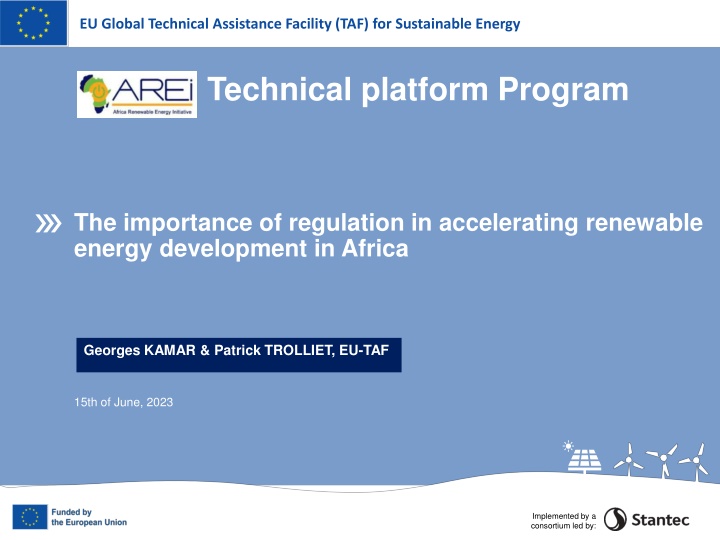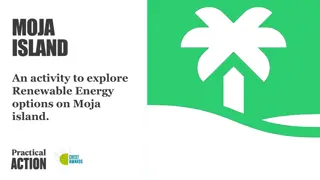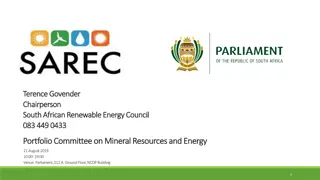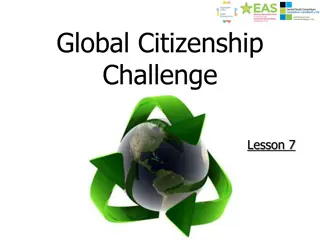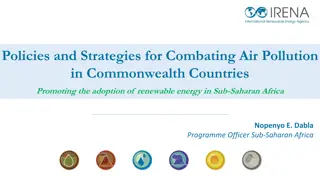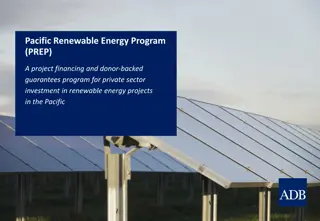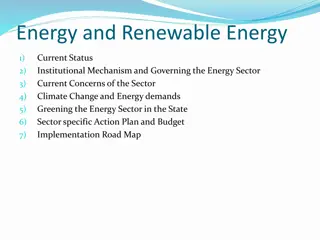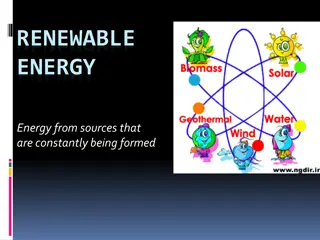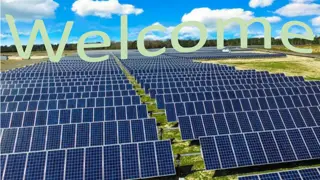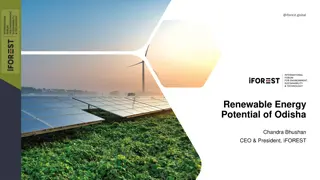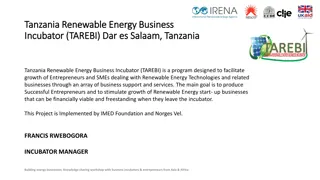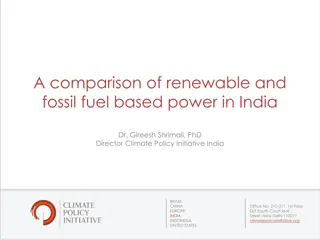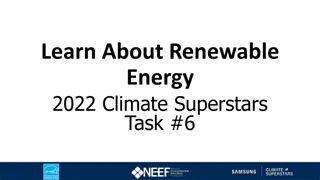Importance of Regulation in Accelerating Renewable Energy Development in Africa
The presentation discusses the significance of regulation in driving the development of renewable energy in Africa. It emphasizes key legal and regulatory requirements such as tariff principles, unbundling, incentives for renewable energy, competition, and transparent procedures. The need for sector unbundling and gradual market opening is highlighted to facilitate the integration of renewable energy sources into the energy sector in African countries.
Download Presentation

Please find below an Image/Link to download the presentation.
The content on the website is provided AS IS for your information and personal use only. It may not be sold, licensed, or shared on other websites without obtaining consent from the author.If you encounter any issues during the download, it is possible that the publisher has removed the file from their server.
You are allowed to download the files provided on this website for personal or commercial use, subject to the condition that they are used lawfully. All files are the property of their respective owners.
The content on the website is provided AS IS for your information and personal use only. It may not be sold, licensed, or shared on other websites without obtaining consent from the author.
E N D
Presentation Transcript
EU Global Technical Assistance Facility (TAF) for Sustainable Energy Technical platform Program The importance of regulation in accelerating renewable energy development in Africa Georges KAMAR & Patrick TROLLIET, EU-TAF 15th of June, 2023 Implemented by a consortium led by:
EU Global Technical Assistance Facility (TAF) for Sustainable Energy Table of content 1. Legal and regulatory requirements 2. Importance of regulators in supporting the implementation of legal and regulatory framework 3. Results of the review of legal and regulatory framework in 38 African countries DISCLAIMER: The information and views set out in this presentation are those of the author(s) and do not necessarily reflect the official opinion of the European Commission. The European Commission does not guarantee the accuracy of the data included in this presentation. Neither the European Commission nor any person acting on the European Commission s behalf may be held responsible for the use which may be made of the information contained therein.
EU Global Technical Assistance Facility (TAF) for Sustainable Energy Key legal and regulatory requirements Typically, legal and regulatory frameworks must, amongst others, include the below key provisions (principles, regulation, and guidelines) to promote for renewable energy. Tariff principles, cost reflective tariff structure & methodology, and tariff regulation Unbundling Establish an independent TSO Incentives for renewable energy (RE), including granting priority network access authorizations, and fiscal and custom exemptions Competition and (gradual) opening of the sector to new market players Independent Regulatory Authority Grid code and a distribution code, with Specific Technical Regulations for Variable RE Third party access to the grid Clear and transparent procedures, terms & conditions for licensing Clear and transparent power purchase agreement (PPA)
EU Global Technical Assistance Facility (TAF) for Sustainable Energy Sector unbundling Incumbent market players might not be too friendly to new RE entrants. In practice, even when provisions are made for third-party access in national legal and regulatory framework, such provisions must be supported by certain conditions, such as the unbundling of sector activities, and the creation of a functionally independent TSO without necessarily structurally unbundle the incumbent utility . Transmission Distribution Generation Supply Competition Regulation Competition Supply to eligible customers
EU Global Technical Assistance Facility (TAF) for Sustainable Energy Gradual opening of the national market Liberalised Market structure Vertically integrated Monopoly Intermediate structure G G G G G G G SG G = Generation SG = Self-generator T = Transport/TSO D = Distribution/DSO S = Supply C = Customer EC = Eligible Customer MO = Market Operator SB = Single Buyer T / SB T T + MO EC D&S D&S D S C C C Several generators and self-generators (renewable energies) A TSO / Single buyer A Distribution / Supply entity Third party access to networks (TPA) Threshold (progressive) for eligible customers Vertically integrated monopoly Customers choose suppliers in full competition Access open to all to transmission and distribution networks Distribution dissociated from supply Towards gradual market liberalisation & lower costs
EU Global Technical Assistance Facility (TAF) for Sustainable Energy Third Party Access to the grid (TPA) Third Party Access (TPA) requires provisions to support competition through opening of the sector to other market participants other than the incumbent Objectives Ensure non-discriminatory TPA Mitigate natural monopolies Regulation of TPA Transmission grids are generally not meant to be duplicated Open access must be set by the legislation as a right recognized for each transmission or distribution grid user (eligible customer, distributor, IPP) against the payment of an access fee The tariffs and conditions of use of the grids should be proposed or validated by the Regulator Grids operators act as a natural monopoly and have a public service mission The criteria and thresholds for eligible customers should be defined Access to grids must be open to third parties, so that genuine competition can take place in generation and supply NB: Not to be confused with Access to energy The conditions of access should be transparent and non-discriminatory towards users rejections must be motivated and monitored by the Regulator
EU Global Technical Assistance Facility (TAF) for Sustainable Energy Clarity and transparency of the licensing process The licensing procedures should clearly map the roles, responsibilities and instruments of various stakeholders, and clarify all schemes (top-down and bottom-up) Key issues 1 2 3 IPP licensing top-down and bottom-up steps & procedures should clearly indicate : Institutions mandates and roles Descriptions of licenses and permits, procurement conditions Existing applications formats, threshold, etc.. Deadlines for each step Exclusivity clause over the concerned site(s) for a specific or pre- defined/agreed period must be mentioned in the licensing process The process should highlight clearly the deadlines for off-takers to respond
EU Global Technical Assistance Facility (TAF) for Sustainable Energy Tariff Principles A major objective: to allow fair and cost reflective remuneration for each sector activity, as well as means to recover investments. Tariff regulation as well as its implementation is considered essential for market liberalisation. Cost reflective tariffs are paramount for transmission and distribution, hinged on a model that provides for the separation of cost along each segment since it is only the transmission or distribution costs that will be required in computing relevant costs of assets used for accessing or wheeling power on the grid. A clear and transparent tariff methodology based on strict power sector organisational accounts separation at the national levels will therefore be necessary to provide efficient price signals and is often one of the early and cardinal tasks of the regulator. The principles for cost reflective tariffs : - Principle of price truth: it reflects the real costs established by the accounting separation - Principle of ease: it is easily understandable for operators - Principle of predictability: it is stable over time, and mechanisms of review are clear. The procedures for setting tariffs vary. The Regulator can either propose tariffs, validate them, or set them ... In all cases, consultation with the Ministries, operators, and consumers is necessary because it is a major political and social issue. Political authorities may decide that the tariffs will not reflect the costs, i.e. to lower social impact. This will require subsidies for the benefit of the aggrieved operators. In this situation, the sector Regulator must ensure compliance with the agreements concluded and the overall financial balance of the sector.
EU Global Technical Assistance Facility (TAF) for Sustainable Energy Principles and incentives to promote RE Priority access to the grid Simplified procedures Tax and customs exemptions Incentives to compensate for RE integration efforts The most common regulatory support is to provide priority network access for RE generators. This can include either support of network connection or priority dispatch once connected to the grid or both Regulators should provide the possibility of easy, inexpensive (small administrative burden and timely response), and non- discriminatory entry for RE developers to the electricity market Duties and Value Added Tax RE integration requires additional efforts from grid companies to maintain operational security. Thus, RE monitoring should pay due attention to preventing discriminatory practices against RE generators Income Tax Holiday for an agreed period (could be scalable) The licensing and permitting regime for RE installations will be crucial in this regard. A one-shop licensing regime might be useful in streamlining the administrative procedures related to RE market entry Transparent and easily available standards Financial incentives Also, carefully designed incentives to compensate for RE connection costs might offset grid company disincentives to integrate RE into their grid Investment support schemes might take the form of investment grants (refundable or non-refundable), supported investment credits (credit support or credit guarantee) or tax credit schemes Technical standards should be transparent, easily available for investors, and should strike the right balance between system reliability needs and simplicity, in order to promote RE penetration.
EU Global Technical Assistance Facility (TAF) for Sustainable Energy Key RE prerequisites to connect to the network RE regulation and monitoring is a relatively new and complex regulatory task, with technical and economic challenges that may prevent their integration into the grid. Connection standards guidelines Grid integration studies Connection agreement RE generation is often constrained by network expansion and upgrade opportunities. Without connection standards and guidelines, the network will be bound to chaos and unnecessary negative impacts. Connection standards will include voltage, frequency, etc. These standards must be specified in the grid or distribution code provisions A grid integration study aims at evaluating a power system with high penetration levels of variable RE, to: Simulate the operation of the power system under different variable RE scenarios to establish where, how much, and over what timeframe to build generation and transmission capacity Identify reliability constraints Evaluate the cost of needed actions Connection agreements to the electricity grid vary widely, depending on the size of the RE system. Connection agreements must comply with the grid or distribution code provisions. Connection agreements will have to do with safety, power quality, and metering. The agreement will also require liability insurance.
EU Global Technical Assistance Facility (TAF) for Sustainable Energy Key Power Purchase Agreement (PPA) provisions In addition to the connection agreement, the IPP shall enter into a power purchase agreement (PPA). A PPA is the contract between the purchaser or off-taker" (often a state-owned electricity utility Single Buyer) and a privately-owned independent power producer (IPP), that provides the primary revenue stream. 1 2 3 The PPA should provide for what happens on termination (whether at end of contract term or early termination for default etc.), including obligations of the IPP to hand-over assets, and what happens to employees. The availability and calculation of an early termination payment will be central to the commercial viability and bankability The structure and risk allocation regime under the PPA is central to the IPP ability to raise finance for the project, recover its capital costs, and earn a return on equity. Typically, IPPs and lenders will require the PPA to run for a long term to guarantee investment recovery PPA should address impact on tariff in the event of a change in applicable law and regulation, as well as the mechanism for tariff adjustment. PPA may also address unexpected currency depreciation ,as well as currency transfer. Government or IFI guarantees could be provided
EU Global Technical Assistance Facility (TAF) for Sustainable Energy Table of content 1. Legal and regulatory requirements 2. Importance of regulators in supporting the implementation of legal and regulatory framework 3. Results of the review of legal and regulatory framework in 38 African countries
EU Global Technical Assistance Facility (TAF) for Sustainable Energy Sector Regulation The establishment of a regulator that is organisationally, financially and operationally independent is fundamental towards implementing an efficient, transparent, and competitive electricity market. The regulator is usually given the responsibility of market development regulation, and licensing Perspectives Strategic Objectives To ensure transparent, and fair competition in the electricity markets To prevent monopolies and discrimination To keep tariffs the closest to real costs Why Regulate? Regulators that are created by legislation (Law or Decree), and their mandates specified by the legislation Regulators that are independent from other branches or arms of the government and regulated utilities Regulators with enough financial resources (royalties & taxes), real power, and more skilled staff to carry out duties with effectiveness Who should Regulate? Any model will have to align with the sector structures that vary from country to country The model of regulation will depend on level of competition, unbundling, and ownership How to Regulate? One model of regulation will not fit all electricity markets
EU Global Technical Assistance Facility (TAF) for Sustainable Energy Strategic role of the Regulator Balancing conflicting interests Concerted efforts Standardizing procedures Regulating the implementation of RE projects requires concerted efforts to put in place mechanisms to stimulate investment, and to integrate these energies into the networks. Regulators must promote a whole series of public policy tools and technical rules to support the use of renewable technologies. Simplification and standardization of procedures are extremely important. This necessarily places the regulator at the heart of the promotion of RE. Regulators must: Balance the interests of the three groups of stakeholders: government, operators, and consumers. Control the complex interactions of variable energies to maintain the reliability of the networks. Ensure that prices are kept as close as possible to real costs. A key element is striking the balance between encouraging investors and protecting consumers, while fulfilling government objectives.
EU Global Technical Assistance Facility (TAF) for Sustainable Energy Prerequisites to an efficient Regulation Independence & Recognition of the role of the Regulators Capacities Regulators must have capacity and experience to : Discuss with technical operators, investors, bankers, Prepare and/or validate supply contracts. purchasing, pricing methodologies Control the sector unbundling, third party access Avoid any discrimination Propose or give an opinion on regulatory amendments Understand and manage all the intricacies of disputes and litigation, etc. To guarantee the independence of the energy Regulators, several prerequisites are essential: Role and powers defined based on clear principles, rules and procedures. Own resources from the payment of a secure, stable and adequate royalties and fees. Recruitment process transparent, clear and impartial. Neutral and fair control to promote and protect competition and private investment. In general, countries with a tradition of customary law are more inclined towards supporting regulatory authorities to fulfill their mission, than civil law countries where the role of the Regulator is often challenged by other public institutions
EU Global Technical Assistance Facility (TAF) for Sustainable Energy Table of content 1. Legal and regulatory requirements 2. Importance of regulators in supporting the implementation of legal and regulatory framework 3. Results of the review of legal and regulatory framework in 38 African countries
EU Global Technical Assistance Facility (TAF) for Sustainable Energy Introduction The legal and regulatory frameworks were assessed in 20 African member States of the network of French-speaking regulators "RegulaE.Fr". The assessment was extended to non-French-speaking countries : 11 western and central African countries, and 7 countries in the Horn of Africa Review carried out as part of support for the network of French-speaking energy regulators (RegulaE.Fr) It includes the assessment of the level of 9 key indicators needed for the integration and regulation of renewable energy and promotion of public private partnerships Mapping and infographics including 38 African countries
EU Global Technical Assistance Facility (TAF) for Sustainable Energy Review of key provisions 1/3 COMELEC WAPP Guin e Bissau Burkina Faso C te d Ivoire Sierra Leone Mauritania Morocco Senegal Gambia Tunisia Nigeria Guinea Algeria Liberia Ghana Benin Niger Libya Togo Mali Independent regulatory authority with power and means to promote and protect competition Separation of sector activities (minimum accounting separation), and establishment of an independent TSO Opening sector to new market players, including eligible customers, and safeguarding against natural monopolies Tariff principles, tariff structure and methodology reflecting transmission and access costs Guarantee of non-discriminatory access by third parties to the network (access obligation) Procedures, conditions, and deadlines, clear and transparent for the granting of exploitation titles Transparent transmission network planning process Clear and transparent framework for resolving complaints and disputes Grid code, in accordance with the regional grid code, and specific technical rules for variable renewable energies Legend Missing/need for reform Existing To complete/Clarify
EU Global Technical Assistance Facility (TAF) for Sustainable Energy Review of key provisions 3/3 HORN OF AFRICA CAPP ISLANDS Centrafrique Madagascar Equatoriale RD Congo Cameroon Mauricius Rwanda Ethiopia Burundi Somalia Djibouti Guin e Soudan Soudan Angola Congo Eritrea Gabon South Kenya Tchad Independent regulatory authority with power and means to promote and protect competition Separation of sector activities (minimum accounting separation), and establishment of an independent TSO Opening sector to new market players, including eligible customers, and safeguarding against natural monopolies Tariff principles, tariff structure and methodology reflecting transmission and access costs Guarantee of non-discriminatory access by third parties to the network (access obligation) Procedures, conditions, and deadlines, clear and transparent for the granting of exploitation titles Transparent transmission network planning process Clear and transparent framework for resolving complaints and disputes Grid code, in accordance with the regional grid code, and specific technical rules for variable renewable energies Legend Missing/need for reform Existing To complete/Clarify
EU Global Technical Assistance Facility (TAF) for Sustainable Energy Review of key provisions 3/3 Regional evaluation COMELEC CAPP WAPP HORN OF AFRICA Independent regulatory authority with power and means to promote and protect competition 1 2 2 4 9 1 1 8 1 4 1 2 Separation of sector activities (minimum accounting separation), and establishment of an independent TSO 3 2 3 10 1 3 4 3 3 4 Opening sector to new market players, including eligible customers, and safeguarding against natural monopolies 1 4 3 11 2 6 2 3 4 Tariff principles, tariff structure and methodology reflecting transmission and access costs 3 2 2 7 5 7 3 3 1 3 Guarantee of non-discriminatory access by third parties to the network (access obligation) 3 2 11 2 1 8 1 1 5 1 1 Procedures, conditions, and deadlines, clear and transparent for the granting of exploitation titles 2 2 1 5 8 1 2 6 2 2 2 3 Transparent transmission network planning process 2 3 3 1 10 3 7 3 4 Clear and transparent framework for resolving complaints and disputes 2 2 1 7 7 1 7 2 1 1 5 Grid code, in accordance with the regional grid code, and specific technical rules for variable renewable energies 2 3 2 7 5 4 6 1 6 Legend Missing/need for reform Existing To complete/Clarify
EU Global Technical Assistance Facility (TAF) for Sustainable Energy Legal & Regulatory mapping Key legal & regulatory recurring gaps RE integration : Insufficient technical rules relating to RE, both in on-grid and off-grid Insufficient consideration for obligation of approval, certification or qualification of RE equipment and installers PPP promotion : Lack of clear, simplified, and transparent RE projects procurement Involvement of Regulators before contracts are awarded to ensure a balanced risk allocation Cloudy electricity tariff process, while the Regulator is supposed to be involved in tariff methodology RE regulation : Defective articulation of sectoral and PPP laws Lack of specific procedures for rural electrification, or no provision for intervention by the Regulator adapted to the specificities of these projects Confined role for Regulators , limited to supervision with few power and statutory guarantees Existing Legend To be completed/specified RE Promotion is To be developed
EU Global Technical Assistance Facility (TAF) for Sustainable Energy THANK YOU FOR YOUR ATTENTION georges.kamar@eutaf.eu Georges KAMAR experttp15@gmail.com Patrick TROLLIET
